North America is home to about 3,400 species of spiders. Spiders are arachnids, and they’re related to scorpions, mites, and ticks. Unfortunately, spiders can and do make their way into our homes. Thankfully, the most common types of house spiders are harmless to humans, but there are exceptions.![]()
The seven most common types of house spiders include:
- American House Spider
- Long-Bodied Cellar Spider
- Brown Recluse
- Sac Spiders
- Jumping Spiders
- Wolf Spiders
- Hobo Spiders / Funnelweaver
Let's look at each of these types of spiders in detail.
American House Spider
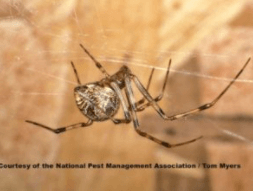
The American House Spider is a comb-footed spider, a common type known for its webs. They’re part of a group known as cobweb spiders, usually building the webs in places like basements, closets, and crawl spaces.
- Color: Brown, tan, or greyish with darker brown patterns
- Size: small to medium (about the size of a nickel including the legs)
- Features: rounded abdomen
Typically harmless, these spiders create messy webs that look unsightly.
Long-Bodied Cellar Spider
Sometimes referred to as daddy longlegs, the long-bodied cellar spider is not the same thing as a daddy longlegs. The Burke Museum states that while the daddy longlegs are also arachnids, they’re harvestmen, “ground-dwelling outdoor creatures,” with only one body section and two eyes. Spiders have two body sections and usually eight eyes.
The long-bodied cellar spider builds webs, often in basements, cellars, crawl spaces, garages, and other dark spaces.
- Color: light brownish-tan, beige, or grey
- Size: small, round body
- Features: long, skinny legs
The cellar spider is not venomous.
Brown Recluse
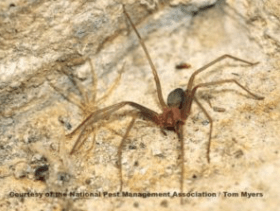
The brown recluse is part of the brown spider family. According to the Department of Entomology at Penn State, the brown recluse is established in 15 states and can be found across the country in climates that range from the high humidity of Florida to the arid desert regions of Arizona and the cooler temperatures of the Midwest. You can find them indoors in basements, attics, crawl spaces, between walls, in furniture, and even in clothing. They’re often carried into the home via boxes and bags.
- Color: brown or greyish
- Size: oval body, about 1/3” long
- Features: 3 pairs of eyes plus dark, violin-shaped marking on body
The brown recluse’s venom has a cytotoxin that can affect the tissue at the bite site. Medical treatment is needed, as dangerous reactions from the venom can occur. These may include but are not limited to chills, fever, rash, pain, and nausea. Children are more sensitive to spider bites than healthy adults and may suffer life-threatening reactions, reports the University of Rochester Medical Center.
Sac Spiders
Sac spiders don’t make webs. It’s typical to discover these spiders near the ceiling or high along the wall. The sac spider is active year-round, usually at night.
- Color: light-colored, yellow, beige
- Size: oval body, about 1/2” long
- Features: 2 rows of 8 small eyes
Harmless to most individuals, sac spider bites can produce swelling and slight soreness at the site. Anyone with spider bite allergies or sensitivities may experience a reaction that could need treatment.
Jumping Spiders
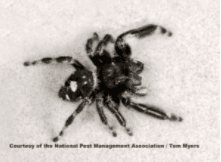
Jumping spiders tend to hunt for prey during the day. You may spot them on the inside of a window, screen door, along a wall, or any surface exposed to daylight. They move in quick jumps.
- Color: brown, black, tan, grey, beige
- Size: compact, almost an inch long
- Features: dense hairs, front legs that are longer than the others
The jumping spider’s bite is similar to a bee sting, but usually harmless. Children or anyone allergic to spider bites may experience a reaction, which can differ from person to person.
Wolf Spiders
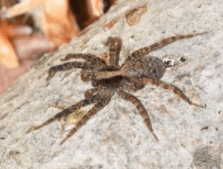
Wolf spiders are larger than many of the other common household spiders. They may enter your home through foundation cracks, windows, or come in through an attached garage. Considered a hunting spider, they eat insects and even can make good pets.
- Color: brown, black, tan, greyish-beige
- Size: large, bodies longer than an inch
- Features: elongated body with hairy-looking legs
Harmless to humans, brown-colored wolf spiders sometimes are mistaken for the brown recluse. However, anyone allergic to spider bites may suffer a reaction that could require medical treatment.
Hobo Spiders / Funnelweaver
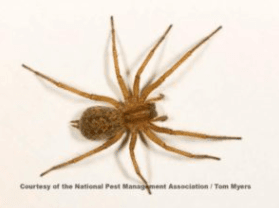
The hobo spider is considered an aggressive spider that builds funnel-like webs. They’re also known as funnelweavers and commonly mistaken for brown recluse and wolf spiders because of their brownish color. You may find them in dark areas of the basement or hiding under the fireplace wood pile.
- Color: brown, tan
- Size: oblong body about 1/2” long
- Features: solid color with no markings
Funnelweavers or hobo spiders are not dangerous, but some people may experience irritation at the site of a bite. As with other spider bites, children can experience a stronger reaction than an adult.
Need Help with House Spiders in the Savannah Area?
Even though most common house spiders don’t pose a threat to humans, you may not want them sharing your home. We can help prevent them! Our trained field professionals apply product around the exterior of your home as well as target doorways and window openings. Doing this eliminates the spiders food sources. Furthermore, our field professionals sweep away accessible, visible webs.
If you’re experiencing an invasion, or simply one or two sighting, contact us!
